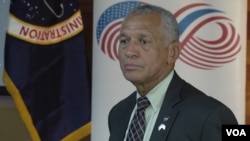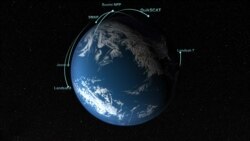The administrator of the U.S. National Aeronautics and Space Administration (NASA) says attention must be paid to new data forecasting an approximately one meter rise in sea levels by the turn of the century.
“It sounds definitive and ominous because that’s the way nature works,” Charles Bolden Jr. told VOA Friday in Bangkok.
His comment came after a team of NASA scientists in the U.S. Wednesday briefed reporters on their research documenting an average nearly eight centimeter global sea level rise since 1992, the result of warming waters and melting ice.
Watch NASA's visualization of predicted sea level rises:
“Given what we know now about how the ocean expands as it warms and how ice sheets and glaciers are adding water to the seas, it’s pretty certain we are locked into at least three feet (0.91 meters) of sea level rise, and probably more,” by 2100, said Steve Nerem of NASA’s Sea Level Change Team and a professor of engineering aerospace sciences at the University of Colorado.
The data is especially significant for Asia where more than 150 million people live within one meter of the current sea level.
“We still have time to make a difference if we’ll pay attention to what the data says,” Bolden, a retired U.S. Marine Corps major general and former astronaut, said during the VOA interview.
Watch the rise in sea levels from 1992 to 2014:
Next Monday in the Thai capital the NASA boss will launch, in conjunction with the U.S. Agency for International Development (USAID) and the Asian Disaster Preparedness Center (ADPC) a regional five-year geospatial data for development project called SERVIR-Mekong.
Utilizing 30 years of archival earth science data, plus daily, real time information for earth-observing satellites, the project will give policy makers and farmers in Cambodia, Laos, Myanmar, Thailand and Vietnam ways to mitigate climate change effects, and aid in drought and flood planning and disaster planning and relief.
SERVIR-Mekong will “help you and your people in your government, scientists and farmers to understand how our climate is changing,” the NASA administrator told an audience of Thai school children Friday who participate in the worldwide Global Learning and Observations to Benefit the Environment (GLOBE) Program.
Noting the contentious debate over to what extent human activity is responsible for global warming and what steps should be taken by the U.S. and other governments, Bolden told VOA that “NASA is a data-providing agency, we don’t make policy.”
NASA’s scientists say about one-third of the rise in sea levels is due to the expansion of warmer ocean water, one-third to ice loss from the polar ice sheets and the remaining to melting mountain glaciers.
The NASA boss, in the VOA interview Friday, expressed no doubt he believed significant climate change had occurred since he had lived in Bangkok in 1972-'73, while he was a fighter pilot in the Vietnam War.
“I’ve already noticed it’s not the same Thailand from a climate standpoint,” recalling downpours that would drench Bangkok like clockwork between 3 and 4 p.m. “The weather patterns have changed, the climate has changed,” he said.
Watch a visualization of NASA's Earth Observing Fleet:


















